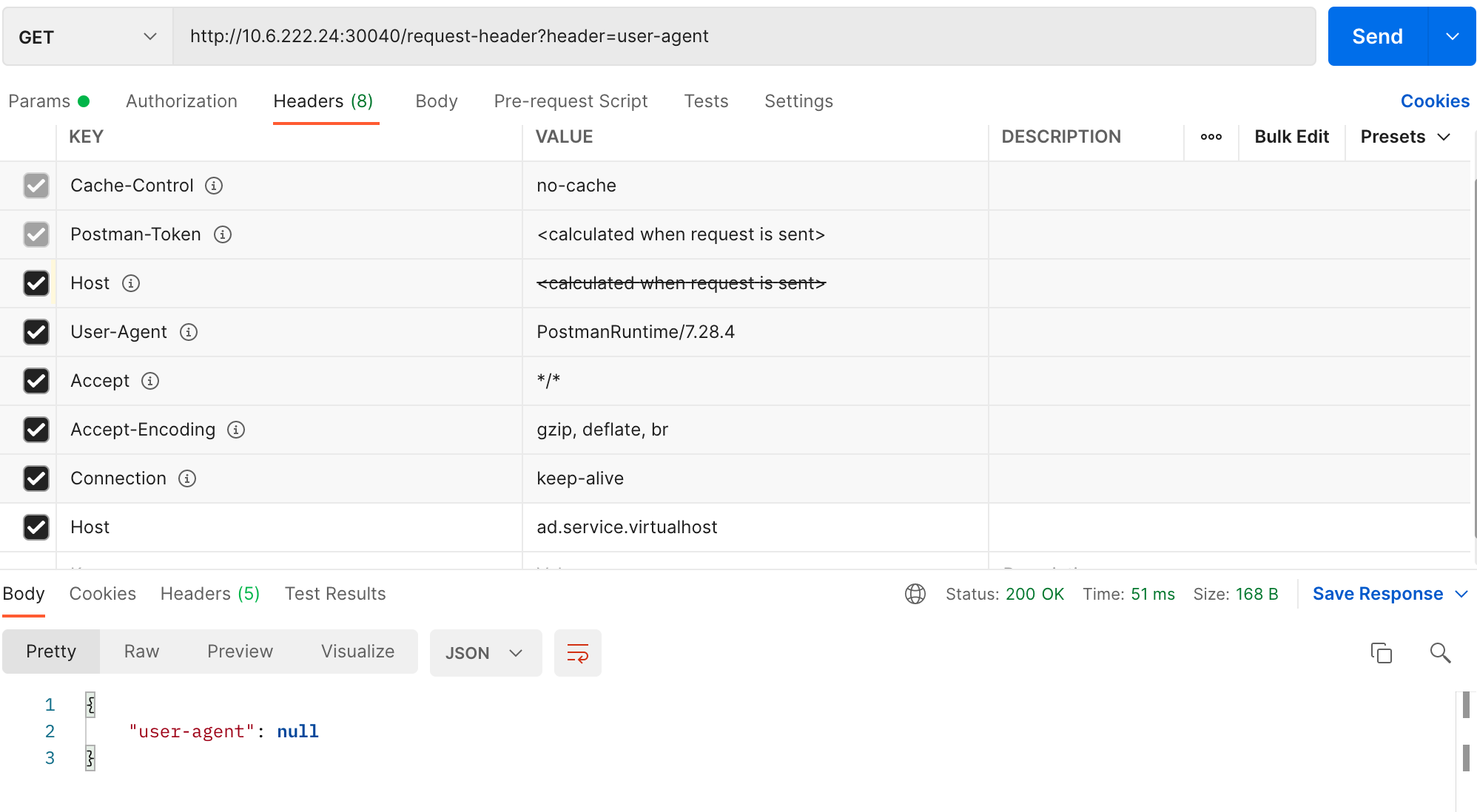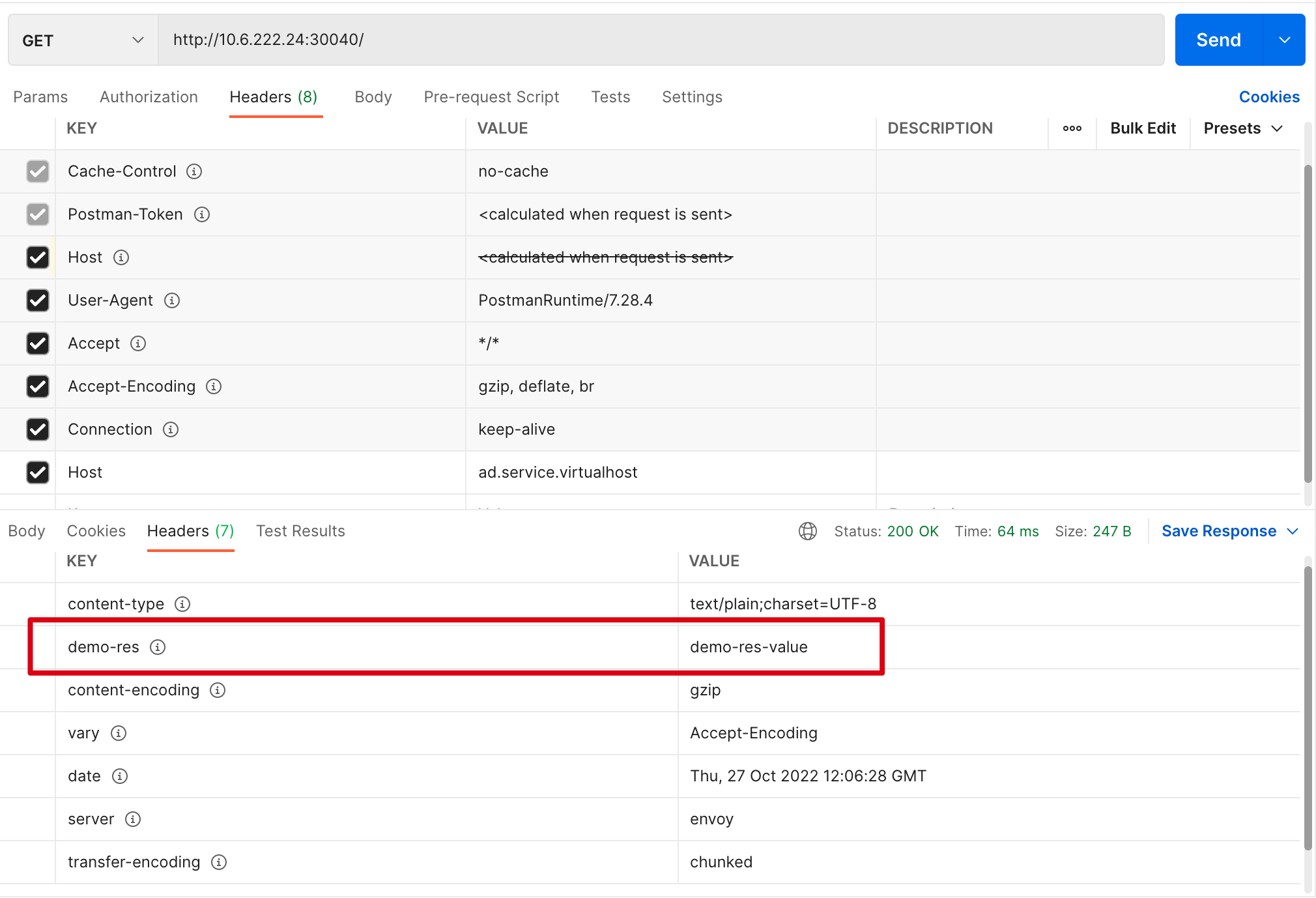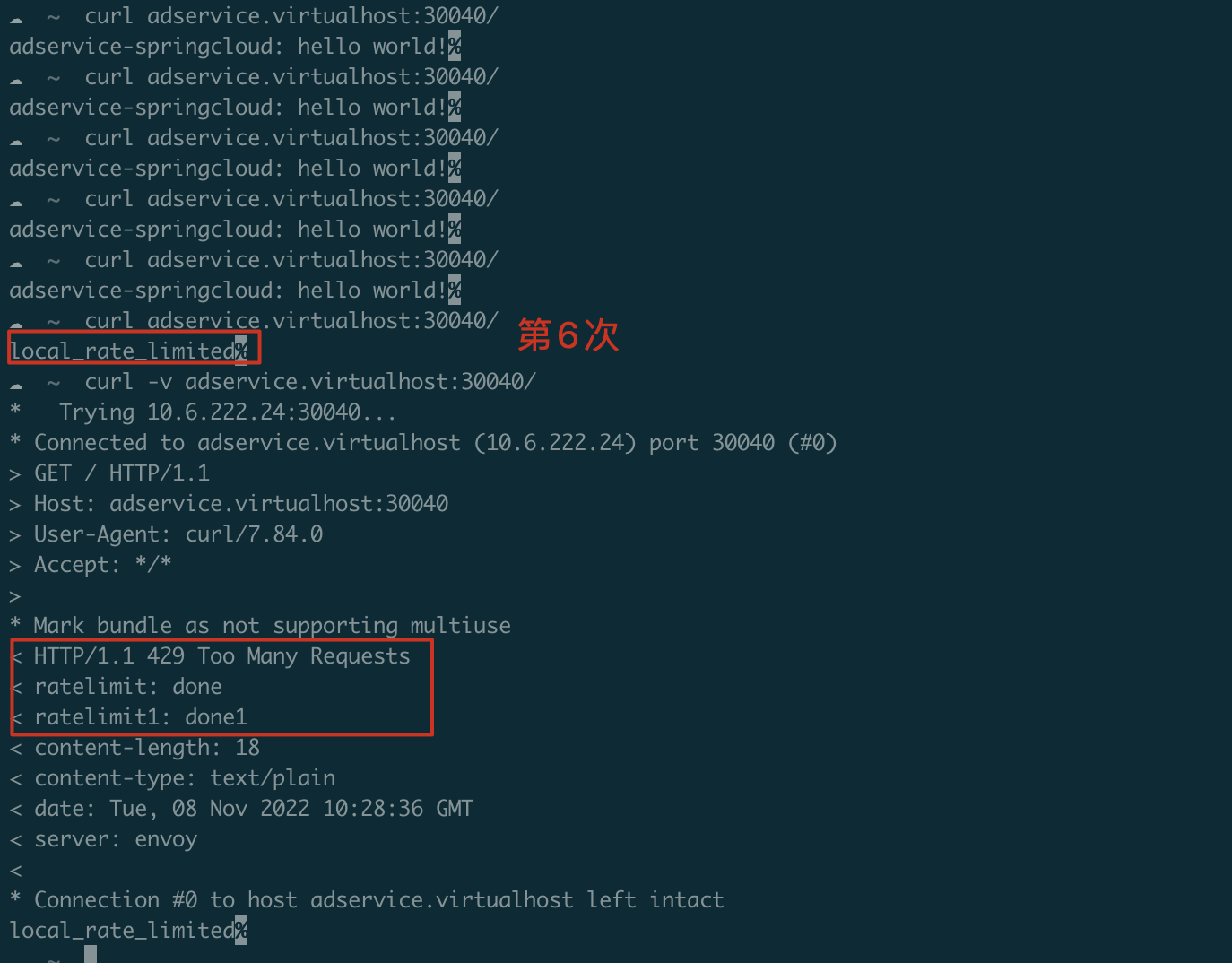Gateway API Policies¶
DCE 5.0 cloud native gateway supports several API policies, including load balancing, timeout, retries, and blacklisting/whitelisting. This article demonstrates how to configure these policies and their specific effects using a real microservice application.
Note
- For detailed configuration steps and parameter explanations for each policy, refer to API Policy Configuration.
- This article focuses on showcasing the effects of each policy and may omit some configuration steps.
Prerequisites¶
- Prepare a demo service, such as
my-otel-demo-adservice. - Create a gateway, domain, and API.
- Connect the demo service to the gateway as explained in Connecting Services to the Gateway.
Load Balancing¶
- Scale the demo service to multiple replicas for load balancing demonstration.
- Configure the load balancing policy following the instructions in Load Balancing.
-
Write a script to record the traffic received by each service replica.
Click to view the script content
import requests def lb_pod_count(): pod1_ip = "10.244.1.135" # IP address of the service replica's node pod2_ip = "10.244.2.207" # IP address of the service replica's node pod3_ip = "10.244.3.193" # IP address of the service replica's node pod1_count = 0 pod2_count = 0 pod3_count =0 host = "http://10.6.222.24:30040/ip" # Service access address headers = {"Host": "ad.service.virtualhost"} for i in range(300): res_ip = requests.get(host, headers=headers).text[11:] if res_ip == pod1_ip: pod1_count += 1 elif res_ip == pod2_ip: pod2_count += 1 elif res_ip == pod3_ip: pod3_count += 1 print("Traffic directed to %s: %d" %(pod1_ip,pod1_count)) print("Traffic directed to %s: %d" %(pod2_ip,pod2_count)) print("Traffic directed to %s: %d" %(pod3_ip,pod3_count)) if __name__ == '__main__': lb_pod_count() -
The effect of random load balancing is as follows. Each replica receives traffic randomly, resulting in some replicas being under more load.
-
The effect of round-robin load balancing is as follows. Each replica receives traffic in a round-robin fashion, resulting in a similar total traffic load for each replica.
Rewrite Path¶
-
In the initial state, accessing the root path of the service returns the content as shown in the image.

-
Configure the path rewriting policy to change the access from the root path to the
/test2endpoint. -
The effect is shown in the image. From the returned content, it can be seen that the accessed endpoint has changed, and the returned data has also changed.

Configure Timeout¶
-
Enable the timeout configuration and set it to consider the request as failed if the response exceeds 3 seconds.
-
Use the dedicated test endpoint
/timeoutto make the request respond within 1 second. The expectation is that the request will succeed.The image below shows a successful access, and the interface returns the set request time.

-
Use the dedicated test endpoint
/timeoutto make the request respond within 4 seconds. The expectation is that the request will fail.The image below shows a failed access, and the interface returns an upstream request timeout message.

Retry Mechanism¶
-
Enable the retry configuration with a maximum of 6 retries when the request fails, and consider it a retry failure if the retry response time exceeds 1 second.
-
Use the dedicated test endpoint
/set-retry-countto make the/retryendpoint of the service require 3 requests to succeed.
Access the
retryendpoint.With 6 retries, it is expected to succeed.

-
Use the dedicated test endpoint
/set-retry-countto make the/retryendpoint of the service require 7 requests to succeed.
Access the
retryendpoint.With 6 retries, it is expected to succeed as well. Because the initial successful request plus the 6 retries after failure adds up to the required 7 requests.

-
Use the dedicated test endpoint
/set-retry-countto make the/retryendpoint of the service require 8 requests to succeed.
Access the
retryendpoint.With 6 retries, the first attempt is expected to fail. Because the initial successful request plus the 6 retries after failure can only reach a maximum of 7 requests, which is not enough for the required 8 requests.
However, manually accessing the endpoint again will show a successful access. At this point, the accumulated number of accesses has reached 8.

Rewrite Request Header¶
-
Enable the request header rewriting policy to remove the
user-agent(case-insensitive) header and adddemo-reqwhen making requests to the service. -
Use Postman tool to view the request headers present in the initial state. It can be seen that
user-agentexists, butdemo-reqis not present.
-
Use the dedicated test endpoint
/request-headerto check if the request includes theuser-agentheader.The returned value of
user-agentis null, indicating that the header has been removed and the rewriting policy is effective.
-
Use the dedicated test endpoint
/request-headerto check if the request includes theuser-agentheader.The expected value is returned, indicating that the header has been added and the rewriting policy is effective.

Rewrite Response Header¶
-
Enable the response header rewriting policy to remove the
x-envoy-upstream-service-time(case-insensitive) response header and adddemo-res. -
Use Postman tool to view the response headers in the initial state. It can be seen that
x-envoy-upstream-service-timeexists, butdemo-resis not present.
-
Access the service directly.
The response headers do not include
x-envoy-upstream-service-time, butdemo-resis present, indicating that the rewriting policy is effective.
WebSocket¶
-
Write a script to test WebSocket connections.
Click to view the script
<!DOCTYPE html> <html lang="en"> <head> <meta charset="utf-8" /> <meta http-equiv="X-UA-Compatible" content="IE=edge"> <meta name="viewport" content="width=device-width, initial-scale=1"> <title>Local WebSocket Test</title> <meta name="robots" content="all" /> <meta name="keywords" content="Local, WebSocket, Testing Tool" /> <meta name="description" content="Local, WebSocket, Testing Tool" /> <style> .btn-group{ display: inline-block; } </style> </head> <body> <input type='text' value='Communication address, starting with ws://' class="form-control" style='width:390px;display:inline' id='wsaddr' /> <div class="btn-group" > <button type="button" class="btn btn-default" onclick='addsocket();'>Connect</button> <button type="button" class="btn btn-default" onclick='closesocket();'>Disconnect</button> <button type="button" class="btn btn-default" onclick='$("#wsaddr").val("")'>Clear</button> </div> <div class="row"> <div id="output" style="border:1px solid #ccc;height:365px;overflow: auto;margin: 20px 0;"></div> <input type="text" id='message' class="form-control" style='width:810px' placeholder="Message to be sent" onkeydown="en(event);"> <span class="input-group-btn"> <button class="btn btn-default" type="button" onclick="doSend();">Send</button> </span> </div> </div> </body> <script src="https://code.jquery.com/jquery-3.1.1.min.js"></script> <script language="javascript" type="text/javascript"> function formatDate(now) { var year = now.getFullYear(); var month = now.getMonth() + 1; var date = now.getDate(); var hour = now.getHours(); var minute = now.getMinutes(); var second = now.getSeconds(); return year + "-" + (month = month < 10 ? ("0" + month) : month) + "-" + (date = date < 10 ? ("0" + date) : date) + " " + (hour = hour < 10 ? ("0" + hour) : hour) + ":" + (minute = minute < 10 ? ("0" + minute) : minute) + ":" + ( second = second < 10 ? ("0" + second) : second); } var output; var websocket; function init() { output = document.getElementById("output"); testWebSocket(); } function addsocket() { var wsaddr = $("#wsaddr").val(); if (wsaddr == '') { alert("Please fill in the WebSocket address"); return false; } StartWebSocket(wsaddr); } function closesocket() { websocket.close(); } function StartWebSocket(wsUri) { websocket = new WebSocket(wsUri); websocket.binaryType = "arraybuffer"; websocket.onopen = function(evt) { onOpen(evt) }; websocket.onclose = function(evt) { onClose(evt) }; websocket.onmessage = function(evt) { onMessage(evt) }; websocket.onerror = function(evt) { onError(evt) }; } function onOpen(evt) { writeToScreen("<span style='color:red'>Connection established, you can now send messages!!!</span>"); } function onClose(evt) { writeToScreen("<span style='color:red'>WebSocket connection closed!!!</span>"); websocket.close(); } function onMessage(evt) { writeToScreen('<span style="color:blue">Server response ' + formatDate(new Date()) + '</span><br/><span class="bubble">' + evt.data + '</span>'); } function onError(evt) { writeToScreen('<span style="color: red;">Error occurred:</span> ' + evt.data); } function doSend() { var message = $("#message").val(); if (message == '') { alert("Please fill in the message to send"); $("#message").focus(); return false; } if (typeof websocket === "undefined") { alert("WebSocket is not connected yet, or connection failed, please check"); return false; } if (websocket.readyState == 3) { alert("WebSocket is already closed, please reconnect"); return false; } console.log(websocket); $("#message").val(''); writeToScreen('<span style="color:green">Message you sent ' + formatDate(new Date()) + '</span><br/>' + message); websocket.send(message); } function writeToScreen(message) { var div = "<div class='newmessage'>" + message + "</div>"; var d = $("#output"); var d = d[0]; var doScroll = d.scrollTop == d.scrollHeight - d.clientHeight; $("#output").append(div); if (doScroll) { d.scrollTop = d.scrollHeight - d.clientHeight; } } function en(event) { var evt = evt ? evt : (window.event ? window.event : null); if (evt.keyCode == 13) { doSend() } } </script> </html> -
Save the above script as an HTML file and double-click to open it.
-
Without enabling the WebSocket policy, click Connect , and it will display an access failure.
-
Enable the WebSocket policy.
-
Click Connect again, and it will display a successful connection, indicating that the WebSocket policy is effective.
Local Rate Limiting¶
-
Enable the local rate limiting policy.
The settings in the image below mean that only 3 normal requests are allowed per minute, but 2 overflow requests are allowed. So, a total of 5 requests are allowed per minute. If the number of requests exceeds 5, it will return a
429status code with theratelimit=doneandratelimit1=done1response headers. -
Access the service using the curl command.
It can be seen that on the sixth access, it returns the
local_rate_limitinformation, indicating that the access failed due to rate limiting.Additionally, the response includes the 429 status code and the two newly added response headers.

Health Checks¶
-
Enable the health check policy.
Without setting a path rewrite, the normal access is to the root path
/of the service. However, if the check path is set to/test, the health check is expected to fail, resulting in the service being inaccessible.
-
Modify to the correct check path. It is expected to pass the health check, and the service can be accessed normally.

Rewrite Cookie¶
-
Enable the cookie rewriting policy.
When rewriting, make sure that the cookie name matches the existing cookie name so that the original attributes can be overridden by the newly set attributes.
-
Use the test-specific endpoint
/cookie-setto set the cookie attributes in the request and carry the actual effective cookie attributes in the response headers.The cookie set by the gateway request is:
Cookie{name='cookie-name', value='cookie-value', maxAge=PT-1S, domain='test.domain', path='/path', secure=false, httpOnly=false, sameSite='Lax'}The response headers show the actually effective cookie:
cookie-name=cookie-value; Secure; Domain=rewrite.domain; SameSite=Strict; Path=/rewrite/path